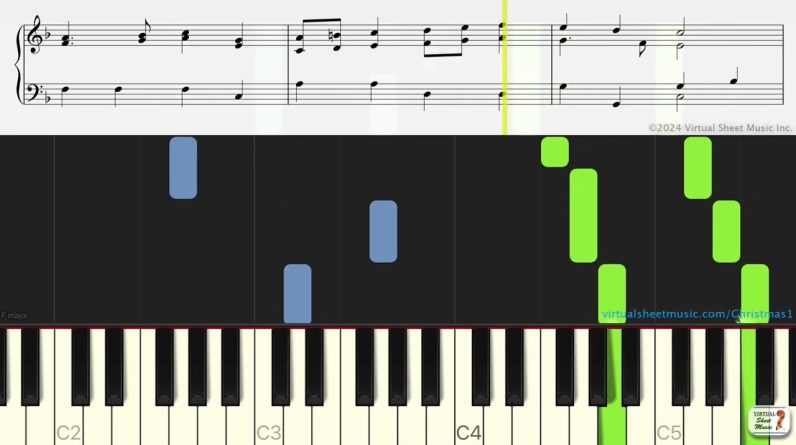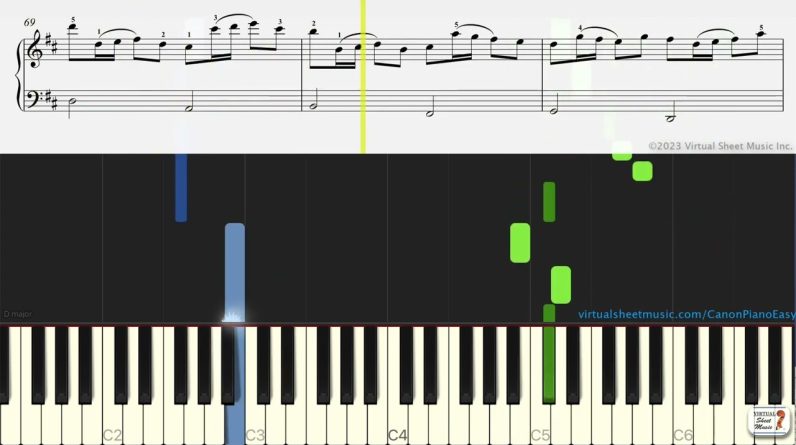This is a great way to learn the Clair de Lune by Claude Debussy and also learn to read music at the same time.
You can practice with this very same video on Virtual Sheet Music® by using their exclusive interactive player which allows you to slow-down or speed-up the music, set up loops, and more.
It’s the perfect tool to practice and learn to read music at the same time!
You will find the high quality sheet music, audio Mp3, MIDI files and interactive sheet music here:
Claude Debussy: Clair de Lune (New Edition) for piano solo
“Great way to get music, thank you, livingpianos.com for the suggestion!”
The Beautiful Claire De Lune by Debussy
Inspired by a poem by Paul Verlaine and influenced by the Symbolist movement, ‘Clair De Lune’ paints a vivid picture of an idyllic, melancholic scene. Though simpler in terms of piano technique compared to Debussy’s other works, playing ‘Clair De Lune’ requires precise attention to touch and dynamics. Fortunately, Debussy himself offered guidance, emphasizing the importance of flexibility and the correct use of pedals. So, dive into the magical world of ‘Clair De Lune’ and let the piano keys transport you to a realm of pure musical bliss.
Overview of ‘Clair De Lune’
‘Clair De Lune’ is undoubtedly one of Debussy’s most popular piano pieces. This timeless composition holds a special place in the hearts of music enthusiasts and has captivated audiences for generations. It is part of his larger work, Suite Bergamasque, but stands out on its own as a masterpiece of its own accord.
Debussy wrote three different versions of ‘Clair De Lune,’ each based on a poem by the esteemed French poet, Paul Verlaine. This shows the profound inspiration that Debussy drew from literature, using Verlaine’s evocative words to create a musical interpretation that tugs at the heartstrings.
In addition to the influence of Verlaine’s poetry, ‘Clair De Lune’ is also deeply rooted in the Symbolist movement. Symbolism, popular during the late 19th and early 20th centuries, sought to convey emotions and visions through suggestive rather than literal means. Debussy expertly incorporated these elements into his composition, resulting in a piece that transports listeners to an idyllic, melancholic scene.
Recommended Recording: Lang Lang
When it comes to the recommended recording of ‘Clair De Lune,’ Lang Lang’s rendition stands out for its exceptional interpretation of the piece’s pictorial nature. Lang Lang, a world-renowned pianist known for his expressive playing, truly brings Debussy’s vision to life.
Lang Lang’s recording of ‘Clair De Lune’ is characterized by his attention to detail and sensitivity to the piece’s descriptive qualities. Through his skilled understanding of dynamics and phrasing, he skillfully captures the ebb and flow of emotions in an utterly captivating manner. Listening to Lang Lang’s interpretation of ‘Clair De Lune’ truly allows you to experience the vivid scenery that Debussy intended to convey.
Piano Technique in ‘Clair De Lune’
Although ‘Clair De Lune’ may not possess the same level of technical complexity as some of Debussy’s other works, it still presents its own unique challenges. The simplicity of the composition lies in its melodic and harmonic structure, but it requires a meticulous attention to touch and dynamics.
One of the notable aspects of playing ‘Clair De Lune’ is the importance of subtle nuances in touch. Debussy’s expressive markings in the score provide guidance on the desired mood and character of each passage. Achieving the desired results requires a sensitive approach to the keys, carefully controlling the weight and speed of each note, and allowing the melody to sing through amidst the accompanying harmonies.
Dynamics also play a significant role in ‘Clair De Lune.’ The piece demands a wide range of dynamics, from delicate pianissimos to soaring fortissimos. Understanding and executing these dynamic contrasts effectively will enhance the experience for both the player and the listener, allowing the emotions to unfold with clarity and impact.
Debussy’s Advice for Playing ‘Clair De Lune’
Debussy himself offered insights and advice on how best to approach playing ‘Clair De Lune.’ He emphasized the importance of flexibility in interpretation, encouraging pianists to explore a range of expressive possibilities. This flexibility allows for a personal connection between the performer and the music, enabling each pianist to bring their unique artistic voice to the piece.
Furthermore, Debussy highlighted the significance of correct pedal usage in ‘Clair De Lune.’ The pedal serves as a tool to enhance the resonance and sonority of the piano, adding depth and richness to the sound. Understanding when to lift and when to depress the pedal is crucial in maintaining clarity while achieving the desired resonance and blending of notes and harmonies.
Debussy’s advice provides valuable insight and guidance for pianists tackling this enchanting composition. By embracing flexibility in interpretation and mastering pedal technique, performers can truly honor Debussy’s intentions and unlock the inherent beauty within ‘Clair De Lune.’
In conclusion, ‘Clair De Lune’ stands as a shining gem in Debussy’s vast repertoire, captivating listeners with its picturesque depiction of a melancholic scene. Lang Lang’s recommended recording beautifully captures the essence of the piece, allowing the listener to immerse themselves fully in the enchanting world that Debussy weaves through his music. While ‘Clair De Lune’ may seem simpler compared to some of Debussy’s other works, it demands an attention to touch and dynamics that ensures a nuanced and evocative performance. By heeding Debussy’s advice on flexibility and pedal usage, pianists can take their interpretation of ‘Clair De Lune’ to new heights, capturing the hearts of audiences worldwide. So, go ahead and dive into the ethereal realm of ‘Clair De Lune,’ and experience the beauty and emotion that this timeless piece has to offer.
- Deck the Halls for Piano Solo – Christmas Sheet Music – Practice Video - November 20, 2025
- Canon in D by Pachelbel | Simplified for Piano Solo | Practice Video - June 22, 2025
- Pianoforall Free Sample Lesson - March 23, 2025







